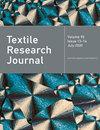异纤检测和清除技术研究进展分析
IF 1.9
4区 工程技术
Q2 MATERIALS SCIENCE, TEXTILES
引用次数: 0
摘要
在本综述中,我们重点介绍了所使用的预处理设备、棉花管道、剔除系统、原棉图像信息的采集和处理,以及棉流动态流速的测量。结果表明,原棉蓬松成厚度更均匀的材料,充分分离棉束可提高后续检测和清除其中异纤的能力。此外,将棉花管道结构与喷嘴板结构优化相结合的研究对于提高棉花中异纤的剔除率也很重要。此外,多光源和电荷耦合器件相机阵列的组合可以提高原棉图像的质量,但光源的功率和波长等关键参数需要优化。由于任何单一的图像分割和特征提取算法都很难适应不同种类异纤的识别,因此必须为此探索多种算法的组合,并开发基于深度学习的异纤检测新技术。最后,识别和清除异纤系统的结构和处理参数也很重要,包括传感器与喷嘴之间的相对距离、检测通道的宽度以及棉流的流速。本文章由计算机程序翻译,如有差异,请以英文原文为准。
Analysis of progress in research on technology for the detection and removal of foreign fibers
We focus in this review on the pre-processing devices used, the cotton pipeline, the rejection system, the acquisition and processing of information from images of raw cotton, and measurements of the rate of dynamic flow of the cotton stream. The results show that raw cotton fluffs into a material with a more uniform thickness, and adequately separating the cotton bunch can improve the subsequent detection and removal of foreign fibers in it. Moreover, research that combines the structure of the cotton pipeline with the optimization of the structure of the nozzle plate is important for improving the rejection of foreign fibers in cotton. Furthermore, a combination of multiple light sources and arrays of charge-coupled device cameras can improve the quality of images of raw cotton, but such key parameters as the power and wavelength of the source of light need to be optimized. As any single algorithm for image segmentation and feature extraction struggles to adapt to the identification of different kinds of foreign fibers, it is important to explore a combination of algorithms to this end, and to develop new techniques of foreign fiber detection based on deep learning. Finally, the structure and parameters of processing of the system for the identification and removal of foreign fibers are important, including the relative distance between the sensor and the nozzle, the width of the detection channel, and the rate of flow of the cotton stream.
求助全文
通过发布文献求助,成功后即可免费获取论文全文。
去求助
来源期刊

Textile Research Journal
工程技术-材料科学:纺织
CiteScore
4.00
自引率
21.70%
发文量
309
审稿时长
1.5 months
期刊介绍:
The Textile Research Journal is the leading peer reviewed Journal for textile research. It is devoted to the dissemination of fundamental, theoretical and applied scientific knowledge in materials, chemistry, manufacture and system sciences related to fibers, fibrous assemblies and textiles. The Journal serves authors and subscribers worldwide, and it is selective in accepting contributions on the basis of merit, novelty and originality.
 求助内容:
求助内容: 应助结果提醒方式:
应助结果提醒方式:


